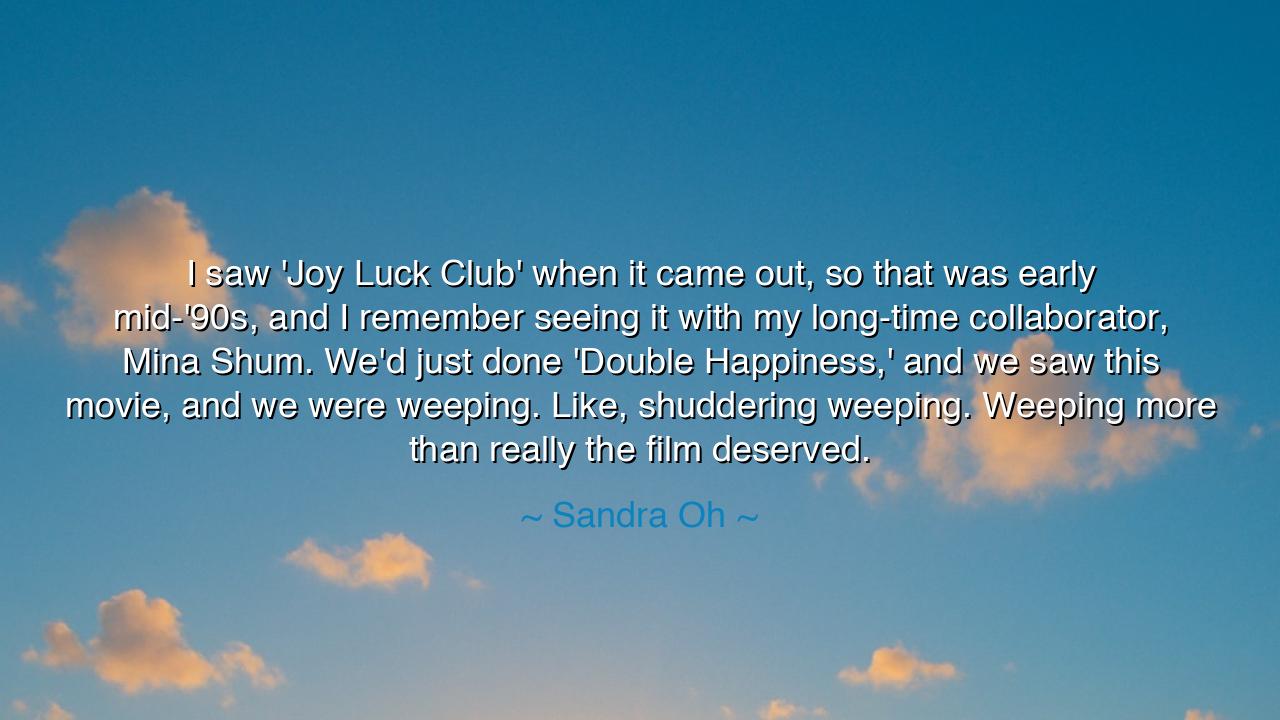
I saw 'Joy Luck Club' when it came out, so that was early
I saw 'Joy Luck Club' when it came out, so that was early mid-'90s, and I remember seeing it with my long-time collaborator, Mina Shum. We'd just done 'Double Happiness,' and we saw this movie, and we were weeping. Like, shuddering weeping. Weeping more than really the film deserved.






When Sandra Oh recalled, “I saw 'Joy Luck Club' when it came out, so that was early mid-'90s, and I remember seeing it with my long-time collaborator, Mina Shum. We'd just done 'Double Happiness,' and we saw this movie, and we were weeping. Like, shuddering weeping. Weeping more than really the film deserved,” she was not merely speaking of a film. Her words reveal a moment of recognition, a moment when art reflected back to her something she had long carried within—the ache of identity, the weight of heritage, and the longing to see one’s own story honored upon the great screen of the world. The tears she describes were not only for the film’s characters, but for the generations of voices who had waited to be heard. In that dark theater, what she wept for was representation, and the sudden, overwhelming beauty of finally being seen.
The origin of this emotion lies in the shared journey of Asian artists in the West, who for decades had labored beneath invisibility, misrepresentation, or silence. In the early 1990s, The Joy Luck Club, directed by Wayne Wang and based on Amy Tan’s novel, was one of the first major Hollywood films to portray Chinese-American families with depth and humanity. For many, it was a revelation: a rare reflection of the complex, emotional, and spiritual worlds of Asian women. Sandra Oh, herself then an emerging actor who had just completed Double Happiness—a film that explored similar themes of culture, identity, and freedom—felt that moment in her bones. When she and Mina Shum wept, it was not for the story alone, but for the history it represented—for the long silence it broke, and for the quiet hope it stirred that new stories, their stories, might now find light.
There is something profoundly human in this kind of weeping—the weeping of recognition. It is the same cry that erupts when the unseen are finally acknowledged, when a mirror is held up to a soul long ignored. The ancients spoke of this through the idea of anagnorisis, the moment of knowing—when a truth, once hidden, is suddenly revealed, and one’s heart trembles beneath its weight. For Sandra Oh, watching that film was such a revelation. It was a sign that art could heal the fracture between who one is and how the world sees them. It was a moment when she, as an artist and as a woman of Asian descent, could feel the boundaries of limitation crack, if only slightly, beneath the pressure of shared truth.
Yet her words—“weeping more than the film deserved”—carry a beautiful humility. She recognizes that the tears came not only from the story’s craft, but from years of collective yearning. It was the emotion of the invisible made visible, the gratitude of a heart starved for representation suddenly being fed. Like travelers finding an oasis in the desert, they drank deeply, not because the water was perfect, but because it existed at all. These tears, then, were not weakness, but witness—a sacred response to history beginning, at last, to change.
This kind of recognition has been felt in other moments throughout time. Consider the story of Zora Neale Hurston, whose book Their Eyes Were Watching God brought the inner life of Black women into American literature at a time when their voices were scarcely heard. When later generations of writers—Toni Morrison, Alice Walker, and others—found her work, they, too, wept, for they saw in her courage a mirror of their own. Just as Sandra Oh and Mina Shum saw in The Joy Luck Club the dawning of a new era for Asian storytelling, these women of letters saw in Hurston the affirmation that their truth, too, belonged to the world. This is the power of art: to awaken what was sleeping, to connect generations through empathy, and to remind the marginalized that their stories matter.
Sandra Oh’s reflection is thus not a mere memory; it is a testimony to the necessity of representation in art. To see oneself in story is to be reminded that one’s existence holds meaning, that one’s culture, language, and struggle have a place in the tapestry of humanity. Her tears were not indulgent—they were sacred. They marked the beginning of a lineage that she herself would continue, becoming one of the most respected actors of her time, blazing trails for others as The Joy Luck Club once did for her. Through her work, she has passed that torch forward, ensuring that others might also weep in recognition—not out of longing, but out of fulfillment.
So, my children of the modern age, learn from this: representation is not vanity—it is visibility, and visibility is life. When you create, create truthfully, for someone unseen is waiting to see themselves reflected in your work. When you witness a story that moves you beyond words, know that your tears are part of something ancient—the healing of invisibility. As Sandra Oh teaches us, those tears are the soul’s way of rejoicing, of saying, “I exist. I belong. I am seen.” And in that recognition, both the artist and the audience are redeemed. For in the end, art’s greatest power is this: to remind us, across all divisions, that we are not alone, and that every story—once silenced—deserves to ring out like a bell across the centuries.






AAdministratorAdministrator
Welcome, honored guests. Please leave a comment, we will respond soon